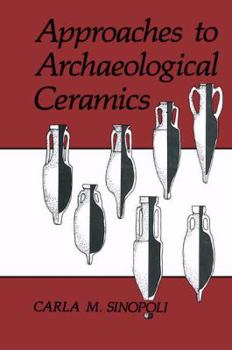Approaches to Archaeological Ceramics
Select Format
Select Condition 
Book Overview
More than any other category of evidence, ceramics ofters archaeologists their most abundant and potentially enlightening source of information on the past. Being made primarily of day, a relatively inexpensive material that is available in every region, ceramics became essential in virtually every society in the world during the past ten thousand years. The straightfor- ward technology of preparing, forming, and firing day into hard, durable shapes has meant that societies at various levels of complexity have come to rely on it for a wide variety of tasks. Ceramic vessels quickly became essential for many household and productive tasks. Food preparation, cooking, and storage-the very basis of settled village life-could not exist as we know them without the use of ceramic vessels. Often these vessels broke into pieces, but the virtually indestructible quality of the ceramic material itself meant that these pieces would be preserved for centuries, waiting to be recovered by modem archaeologists. The ability to create ceramic material with diverse physical properties, to form vessels into so many different shapes, and to decorate them in limitless manners, led to their use in far more than utilitarian contexts. Some vessels were especially made to be used in trade, manufacturing activities, or rituals, while ceramic material was also used to make other items such as figurines, models, and architectural ornaments.
Format:Paperback
Language:English
ISBN:0306435756
ISBN13:9780306435751
Release Date:June 1991
Publisher:Springer
Length:238 Pages
Weight:0.87 lbs.
Dimensions:0.6" x 6.1" x 9.3"
Customer Reviews
3 ratings
Geat Book!
Published by Thriftbooks.com User , 15 years ago
This book was in excellent condition when I got it and shipped quickly. It was also a lot cheaper than the books available at my university's bookstore (even the used copies)!
Chapter by chapter summary
Published by Thriftbooks.com User , 22 years ago
Carla Sinopoli writes with a view to helping the reader "consider how ceramics are used to answer specific questions about the past" p70. Though offering a thick treatment of statistical analysis as applied to ceramics (Chapter 3 and the appendix), she is not interested in ceramics for the sake of data analysis but for the building of an ethnoarchaeological picture of the past. Ceramics are subservient to the task at hand, and as such, the books true strength is in Chapters 4-7 where S. applies the basic principles of Chapters 1-3 to actual field studies.Chapters 1-3 introduce ceramics at their atomic level, starting from material preparation and following through to the completion of a piece of pottery. As the whole book is grounded in the concrete of showing how ceramics answer specific questions, so S.'s discussion of how pottery is created is also practical. As such, a high point of Chapter 2 is when S. takes us on a journey through an actual potter's workshop. By using a model of analogy, she convincingly constructs what the ancient process of pottery making consisted of. The potter's workshop is a case study from modern Kamalapuram, India. Based on personal visits there, S. begins at the beginning of how the family passes along the knowledge of pottery making from generation to generation (much as one would expect of the tradesmen of the ANE). From there, she follows through with the actual labor of gathering the materials for making the clay, the task of shaping pottery (using various methods), primitive firing, and finally the trade, commerce and use of the finished pieces. She provides a layout of the workshop, the familial essence of the operation, and the craftsmanship that under girds it all.Chapter 5 tackles the question of using ceramics to answer questions related to cultural uses of ceramics, along with the production and distribution thereof. Part of the problem of ascertaining ceramic usage from the archaeological find is that pottery is not normally found where it was last used, but has a life cycle of being used, being broken and then being deposited. Therefore, when analyzing sherds, "discard behavior and deposition processes must be taken into account" p86. Ceramic assemblages are formed based on complex human behavior. For example, a piece of pottery created for cooking, once broken, may be employed in such unrelated areas as wall building. Destruction levels are particularly useful to the archaeologists, because it is when destruction comes that pottery is most likely to be left where it was last used. Finding how ceramics are distributed across a site will allow for determining usage patterns. For doing this, it is important for the historian to obtain some accurate accounting of the frequency of different vessel types throughout the site. The problem here is that "the frequencies of vessel types in an archaeological assemblage is not necessarily a direct reflection of their frequency of use at any one point
Sinopoli's Approaches to Archaeological Ceramics
Published by Thriftbooks.com User , 24 years ago
This book is excellent in my opinion for both undergraduate and graduate students in archaeology, as well as current professionals and those who just consider archaeology a hobby. Sinopoli manages to explain the basics of ceramic production, use, and analysis without being either over technical or overly simplified. The structure of the book is excellent as well, with chapters organized into a beginning section introducing the topic of discussion and then followed by a case study to reinforce the ideas and methods put forth in the chapter and giving the book a "real world" appeal. In all, an excellent resource, one that I will probably use throughout my career as an archaeologist.






